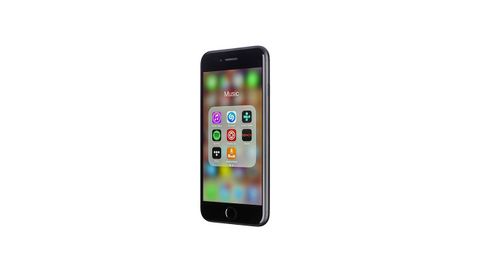Apple has a reputation for deciding it knows best. It led the way in ridding the world of floppy drives, made laptops skinnier by losing the optical drive and turned the internet on its head with its refusal to support Flash on mobile devices.
The iPhone 7 and its lack of headphone jack though, is perhaps Apple’s most controversial move to date.
All the talk around this phone has been more about what it doesn’t have, rather than what it has. And that’s a shame, because what it does have is very impressive indeed.
Features
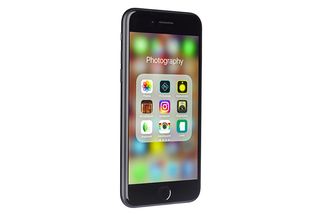
The iPhone 7 is a chip off the old block when it comes to design. It looks similar to the 6S and 6 before it, which is hardly a surprise.
Apple stuck with the basic iPhone 4 design for four years, so it could be another couple of years yet before we see a refresh.
Apple might not be alone in producing beautiful phones these days, but the slim aluminium unibody still looks as slick as ever – it’s only when you look closer that you’ll see the changes.
Firstly, there are new colour options, and the not-quite-silver, not-quite-black Space Grey is no more. It has been replaced by glossy Jet Black and regular matte Black options, which join the existing silver, gold and rose gold colours.
Jet Black is certainly the standout design of this generation, but be warned. Not only is the glossy finish a playground for fingerprints, even Apple itself has admitted it’s more susceptible to ‘fine micro-abrasions’ than the matte design.
MORE: Apple iPhone XR hands-on review

On the back panel, the new camera looks a little different too, boasting a larger lens and positioned a little closer to the edge of the phone.
The upshot of this is that old 6S cases won’t work with the iPhone 7, which is a bit of a shame for upgraders.
Of course, there’s no headphone jack, but the other big change is that the home button is no longer a button. Instead it has been replaced by a solid pressure-sensitive touchpad.
Apple has used the same method here as with the touchpads on its newest MacBooks, replacing the physical clicking action with a clicking sensation, using vibration. It has improved the iPhone’s Taptic Engine to support this, so it feels pretty realistic.
It feels more like clicking the whole of the bottom section of the iPhone, rather than pressing a button, but it does the trick. We only notice one flaw, and that’s when it’s resting flat on a hard surface.
The vibrations don’t seem to fire (or at least, we can’t feel them) so it’s hard to know the pressure you need to apply. Here’s hoping it’s something Apple can fix in a firmware update.

The improved Taptic Engine doesn’t just come into its own on the new home button though – it is used throughout the iPhone 7 to let you know it’s listening.
For example, it’ll give you very gentle nudges when you swipe up for Control Centre or down for Notifications, and a multiple selection menu on a website will deliver a Taptic click with every spin. It all helps to keep the iPhone 7 experience feeling very slick indeed.
TouchID works faster than ever too, so much so that the swipe to unlock step has now gone completely and you’re straight in with just your fingerprint. The new Raise to Wake feature built into iOS10 helps speed things along here too.
One final thing to note is that Apple has finally made the iPhone 7 water resistant, managing up to 30 minutes submerged at depths of up to one metre. This is a long overdue feature, but a welcome one, ensuring your phone will never again meet a watery end in the bath.
MORE: Best smartphones 2018
Sound
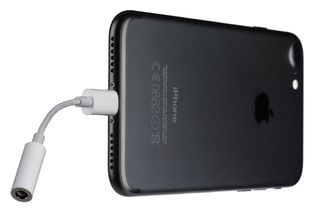
So let’s get right to that missing headphone jack.
Ultimately, you now have three ways to listen to your music on an iPhone 7 – using a pair of Lightning-compatible headphones (a pair of Lightning EarPods are included in the box), a pair of 3.5mm headphones with the included adapter, or wireless headphones.
The adapter is a bit of an un-Apple-like faff, and the fact we can’t charge our phone at the same time as listening to music is a pain, but it’s no more of a dealbreaker than using a 6.3mm to 3.5mm adapter for more pro headphones.
We just left it on the end of our cans for the best safekeeping, though the ability to misplace it is still pretty high – not to mention you might want it with you for use in the car, or at home.
The adapters are £9 a pop, so buying a spare is probably recommended.
MORE: Best wireless Bluetooth headphones

Apple clearly sees the future of audio as wireless (2017's truly wireless AirPods attest to that), but for now, music still sounds better through a physical connection, so for the best quality, we stick with that.
Adapter connected, we settle down to a listening session.
Thankfully all that fuss over the headphone jack hasn’t affected Apple’s ability to make a great sounding phone. It is still the rich, detailed iPhone sound we know and love.
But compare the sound via the adapter to the direct 3.5mm jack of the iPhone 6S, and there are noticeable improvements.
Listen to Starboy by The Weeknd ft Daft Punk and Apple’s undeniable sense of rhythmic timing is tighter still, the fast-paced bassline clung to with toe-tapping precision underneath the vocal track.
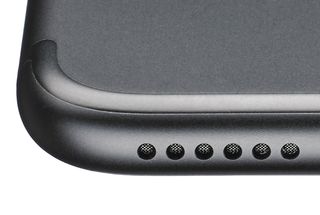
Everything sounds a touch more solid too. There’s more confidence behind every bass kick and vocals sound more sure of themselves, so you get a wholly authoritative performance that oozes enthusiasm.
Elsewhere, it’s business as usual. The treble is clear and open, bass is punchy yet controlled and the midrange is as insightful as ever, if a touch more refined.
The 7 is more expressive though, handling dynamics a touch better than the 6S and creating a more upfront and exciting sound. It’s like the 6S with a caffeine boost, and a job very well done indeed.
Although Samsung’s efforts are much improved this year, we’d still take the iPhone’s sound over any of its current crop of handsets.
But the LG G5 with Hi-Fi Plus module still wins out for us in this department though, offering a real step up in sound across the board. It’s the closest a phone has ever got to real hi-fi, and will certainly take some beating.
MORE: How to play hi-res music on your iPhone
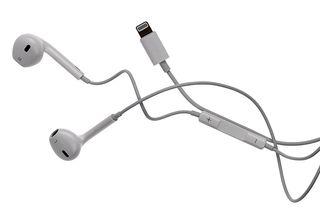
Finally, the iPhone 7 features stereo speakers for the first time – one placed along the bottom edge, and one hidden in the earpiece.
It’s a more direct and involved sound, and adds more weight and volume for shorter watches, but you’re still going to want your headphones for a more detailed or lengthy listen.
As ever, there’s a pair of Apple’s in-ear EarPods included in the box, but this time they’ve been upgraded with the new Lightning connector.
If you’ve tried EarPods before, there’s not a lot else new here. The solid one-size-fits-all design is the same, meaning the fit is still awkward and fails to create a good enough seal to block out the majority of outside noise.
MORE: Apple Lightning and the iPhone 7 - what you need to know
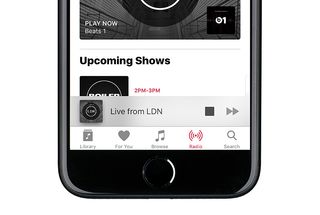
The sound hasn’t changed either, but for a pair of bundled headphones, it’s passable. They show decent treble quality, so music never sounds harsh or bright – half the battle with cheap in-ears.
However, the midrange lacks insight, so vocals can sound thick and missing in detail. Bass could be better defined too.
Of course, plenty of iPhone users are quite happy with their EarPods, but we’d suggest an affordable upgrade, such as the Beyerdynamic Byron BT (£60), for a significant improvement in sound.
Screen
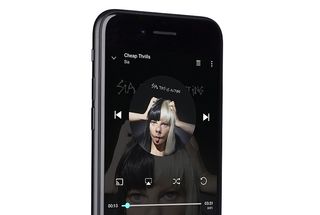
From a pure spec perspective, the iPhone 7’s screen hasn’t changed since the iPhone 6, staying at 4.7in with a 750 x 1334 resolution.
On paper, it’s not a patch on the 2K screens on most Android handsets – heck, it’s not even full HD – but watch a video and its performance really holds its own.
Pictures might not be quite as crisp in comparison with the Galaxy Note 7 and its ilk, but there’s not a lot in it on a screen this size.
Detail levels are pretty similar too, and plenty for an on-the-go Netflix marathon.
The display has seen some tweaks from the iPhone 6S though. It’s a touch warmer, with a 25 per cent brighter screen and a wider colour gamut to allow for more vibrant colours.
MORE: Samsung Galaxy S9 review

Colours are still balanced and realistic, skin tones a touch warmer and lifelike, and brighter hues pack a touch more punch than before.
Contrast is improved too, so blacks are both more detailed and go deeper, while the highlights in a scene pack extra punch to shine with more intensity – if just a touch warmer than before.
In 2016, there’s no denying we’d like Apple to push the regular iPhone up to a Full HD screen at the very least, but the truth is, it still competes with screens almost double its resolution.
The Galaxy S7 offers more than 250 pixels per inch more than the iPhone 7, and it’s barely noticeable for the most part. That says a lot for Apple’s video processing skills.
MORE: Apple iPhone XS Max review
Features
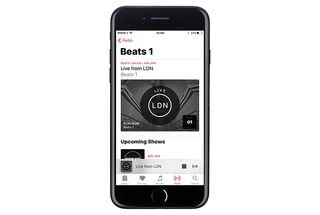
Like every iPhone before it, the iPhone 7 features an upgrade to Apple’s own processing chip.
This time it’s the A10 Fusion chip – a quad-core processor that combines two high-performance cores with two high efficiency cores, a first for Apple.
The idea is that it can split different tasks between the cores depending on their demand, which should preserve battery life.
Apple claims the A10 Fusion offers a 40 per cent greater CPU performance and 50 per cent greater graphics performance than the A9 from the 6S, with some benchmark tests even suggesting it could better the 9X from the iPad Pro – an impressive claim indeed.
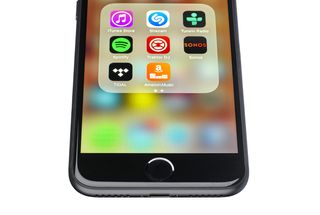
The only problem is that you wouldn’t really know it. It is a touch slicker and more responsive in menu swipes, app loading and multitasking, but not to the extent that it makes the iPhone 6S look slow.
Once app developers catch up and start making apps that harness the A10 Fusion’s power, the chip should really come into its own. We look forward to putting it to the test.
Battery woes have plagued iPhone users since the first handset launched nine years ago, but in the iPhone 7, Apple has finally made a more convincing move. Part of the reason for removing the headphone jack was to accommodate a bigger battery.
Apple says it should last for two hours longer than the iPhone 6S, and we do notice it takes slightly longer before we’re reaching for a charging cable.
MORE: Apple Music review
Camera

The iPhone camera has long been one of the standout smartphone cameras, refusing to chase megapixels and instead concentrating on producing excellent images.
The main camera is still 12MP, but you now get a new six-optic lens, optical image stabilisation (previously only available on the Plus model) and a wider f/1.8 aperture, all for producing better low light shots.
The True Tone flash is made up of four colours now and not two, to make snaps look more natural than before.
In good light, pictures look as sharp as ever, but they’re brighter, with a touch more detail and a better handling of colour.
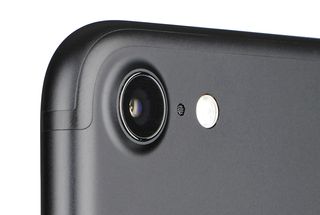
Pictures are usually nailed with one snap too – the autofocus is quick to react and auto HDR mode reliable enough to balance out exposure issues. It might not have the manual controls of its rivals, but it doesn’t really need them.
In low light there are improvements too, offering a lighter, more detailed shot from a relatively dark setting, and keeping the need for flash at bay. It keeps noise to a minimum, but steers clear of over processing and over smoothing for the most natural look it can get.
The selfie camera has also had a boost, from 5MP to 7MP, plus video recording offers steady and detailed footage in either 4K or Full HD.
MORE: Apple HomePod review
Verdict
There’s no doubt the iPhone 7 is the company’s most controversial handset to date.
Removing the headphone jack is sure to upset some users, but this phone is better than the last generation in every way – including its sound.
Headphone jack aside, the changes are careful and considered upgrades rather than great leaps forward. But with an improved screen, better sound, faster performance and improved camera, it’s a nicer phone to use than ever
Even with the controversy, it’s hard not to see the iPhone 7 as another success for Apple. Maybe, just maybe, it does know best.
- See all our Apple reviews
